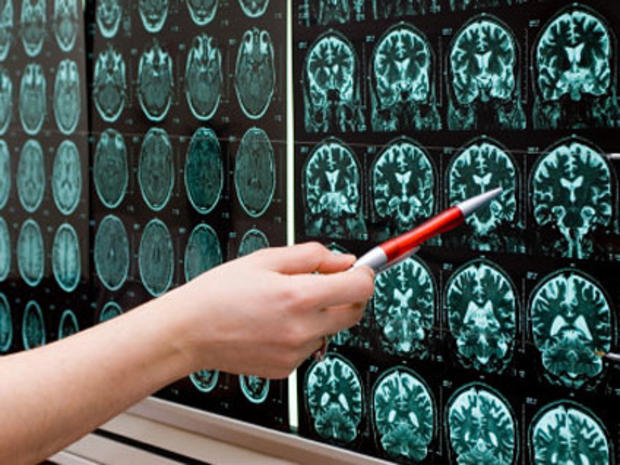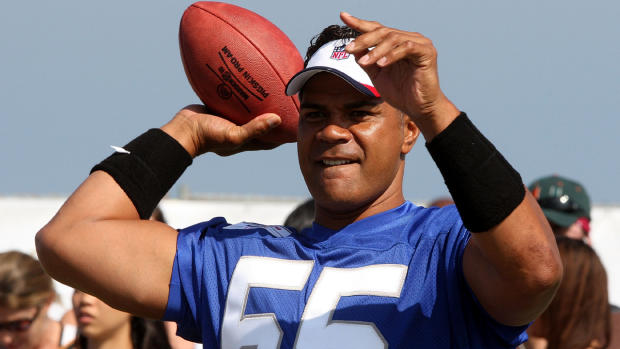Soldiers' brain damage similar to football players', study of chronic traumatic encephalopathy shows
(CBS News) Autopsies in four soldiers who served in the war in Afghanistan reveal similar signs of brain damage that has been seen in NFL and other professional athletes with a history of head trauma, a new study shows.
Junior Seau's death raises questions about brain trauma, chronic traumatic encephalopathy
NFL veteran quits, fearing future brain damagePICTURES: NFL players who donated their brains to science
The autopsies of the soldiers - who were an average age of 32 - showed evidence of chronic traumatic encephalopathy (CTE), a degenerative brain disease that causes memory loss, depression and other Alzheimer's-like symptoms.
CTE has been thrust into the spotlight in recent years following the deaths of several NFL players who battled with depression and/or dementia symptoms during middle age or earlier. Notably, Chicago Bears Safety Dave Duerson committed suicide in 2010 at age 50 after leaving a note that his brain be donated to research, and an autopsy eventually determined he had CTE. This year, the issue reached a fever pitch when former San Diego Chargers star linebacker Junior Seau committed suicide in May, fueling speculation that his career of hard hits took an emotional toll. His family is considering donating his brain to science to find evidence of CTE, ESPN reported.
Dr. Anne McKee, a neuropathologist at Boston University who serves as Co-Director of the Center for the Study of Traumatic Encephalopathy (CSTE), announced Dave Duerson's autopsy results last year. McKee and her colleagues led the new research on military veterans, published in the May 16 issue of Science Translational Medicine.
The disease is evidenced in autopsies by a buildup of tau protein in the form of "neurofibrillary tangles" and threads throughout the brain - these signs are also seen in autopsies of elderly patients with Alzheimer's. McKee and her team found evidence of CTE in the brains of the soldiers, three of which had mild traumatic brain injuries from a roadside bomb blast and one had several concussions but none caused by a blast, USA Today reported.
The researchers then compared their brains to those of three young amateur football players and a professional wrestler - all of whom had a history of repeated head trauma and died in their teens or 20s - and found similar evidence of brain damage. McKee told Science Magazine that athletes with CTE typically display these abnormalities in the brain's frontal lobes, but in the blast-injured veterans, the trauma was more evenly distributed.
"But when you look microscopically, it's very, very similar," she said.
After discovering evidence of CTE in the soldiers, the researchers created a neurotrauma mouse model to find out if a single IED blast could cause brain damage. A typical blast wind from an IED can reach up to 330 miles per hour, larger than any recorded natural wind gust on record. The researchers determined one single IED wind blast could result in behavioral and pathological evidence of brain damage, including impaired learning and memory. This was observed only two weeks after exposure to a single blast. They found the shock waves from the "explosion" had no effect on brain tissue.
"The force of the blast wind causes the head to move so forcefully that it can result in damage to the brain," Dr. Lee Goldstein, an associate professor of psychiatry and neurology at Boston University who co-led the research with McKee, said in a news release.
The researchers then used the model to see if there was a way to prevent brain damage in mice exposed to the simulated blast. They found when the mouse's head was immobilized, it did not display the same learning and memory deficits associated with CTE as the mice whose heads were not immobilized - which the researchers called the "bobblehead effect," the New York Times reported.
"Now that we have identified the mechanism responsible for CTE, we can work on developing ways to prevent it so that we can protect athletes and our military service personnel," Goldstein said in a written statement. "Now that we have identified the mechanism responsible for CTE, we can work on developing ways to prevent it so that we can protect athletes and our military service personnel."
"The animal model developed by the researchers will enable a better understanding of the brain pathology involved in blast injuries and ideally lead to new therapies to help service members and veterans with traumatic brain injuries," Dr. Joel Kupersmith, the chief research and development officer for the Department of Veterans Affairs, which helped fund the research, told the Times.
Colonel Dallas Hack, a physician who coordinates research for the U.S. Armed Forces told Science Magazine the results are suggestive but not conclusive, noting that three of the four soldiers had previous concussions from sports, fights and accidents, and one of the soldiers wasn't even exposed to a blast.
"Whether there is a relationship between CTE and blast ... is definitely a question that we feel needs to be answered," Hack said. "Was their military service part of the cause? We don't know that yet."
The Center for Traumatic Encephalopathy has more on CTE.


